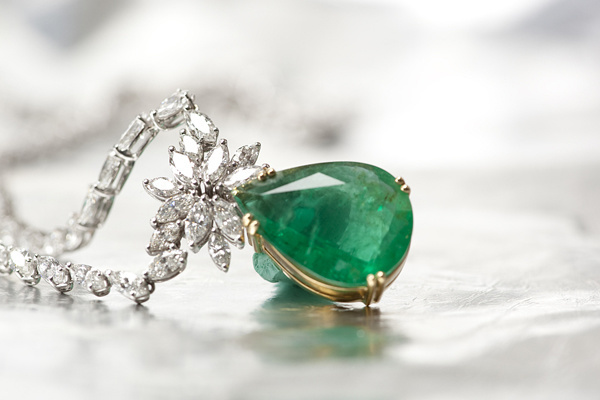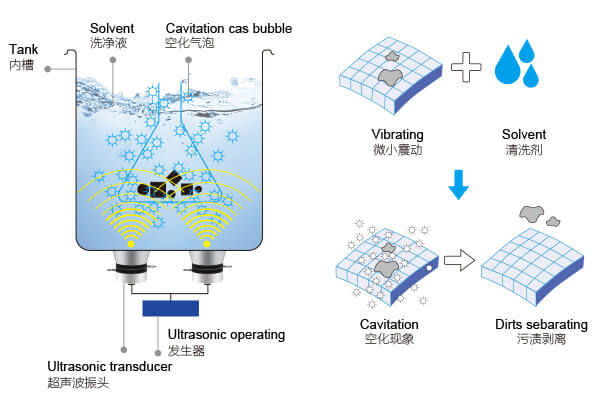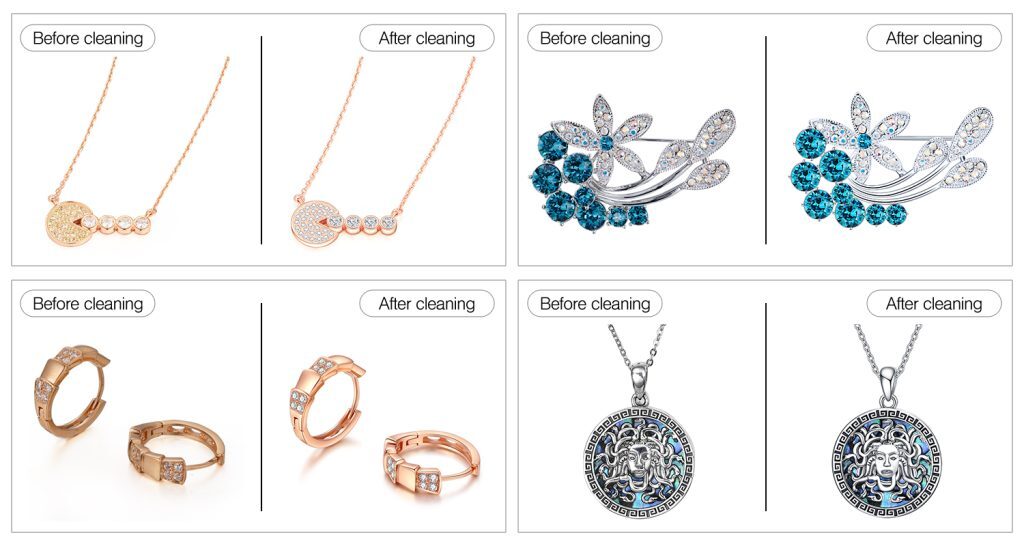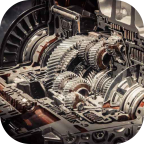Cleaning Pandora Jewelry: Is Ultrasonic Cleaning Safe and Why Dish Soap Isn’t Ideal
Browse Volume:3 Classify:Support
Pandora jewelry holds a special place in the hearts of millions worldwide. From customizable charm bracelets to sparkling rings and delicate earrings, every piece tells a story—personalized, collected over time, and worn with pride. But while their beauty is undeniable, keeping Pandora jewelry clean without damaging it is a challenge that confuses even seasoned jewelry owners.
What makes Pandora pieces so attractive is also what makes them difficult to maintain. A typical Pandora bracelet might include dozens of tiny charms, each made from different materials—sterling silver, 14k gold plating, enamel coatings, Murano glass, synthetic crystals, cubic zirconia, and even silicone-lined clips. These materials are often bonded together with adhesives or feature delicate surface treatments like antiquing or oxidation to give each piece a distinctive vintage look.
The result? You’re not just dealing with a piece of metal. You’re caring for a miniature collection of mixed media, all embedded in one design. And that’s where traditional cleaning methods begin to fall short. Scrubbing can dislodge stones or scratch finishes. Soaking can degrade glue or cloud glass. And using the wrong chemical cleaner can remove the very oxidized finish that gives the charm its character.
It’s no wonder many Pandora owners begin searching for modern alternatives. Ultrasonic cleaners, with their hands-free operation and promise of deep cleaning through microscopic bubbles, seem like a magical solution—one that promises to restore sparkle without manual effort. But is this technology truly compatible with the unique nature of Pandora jewelry?
Before diving into what ultrasonic cleaning really does and why dishwashing detergent complicates the equation, it’s important to understand how Pandora is constructed. Because when it comes to cleaning, not all jewelry is created equal—and Pandora, more than most, requires a thoughtful approach.

Jewelry
What Makes Pandora Jewelry Vulnerable During Cleaning
Pandora’s signature charm lies in its artistic blend of materials. This aesthetic complexity, however, makes its pieces far more fragile than they appear. Unlike solid gold or plain silver jewelry, Pandora products often feature a fusion of components—each with different sensitivities to moisture, heat, pH, and vibration.
At the core of most Pandora items is 925 sterling silver, an alloy of 92.5 percent silver mixed with copper or other metals for durability. While sterling silver is sturdy, it is also prone to tarnishing over time, especially when exposed to air, sweat, perfumes, or chlorine. That’s part of the reason why owners seek thorough cleaning methods. But silver is just the beginning.
Many Pandora charms and rings include hand-applied oxidized finishes that enhance detail. These finishes are intentionally darkened in recessed areas to create a vintage or antique aesthetic. Unfortunately, aggressive cleaning—particularly ultrasonic or chemical—can strip away this oxidation completely, leaving the piece looking unnaturally bright or uneven.
You’ll also find Pandora pieces adorned with enamel coatings, applied in vibrant colors to create floral patterns, hearts, or abstract designs. Enamel, though beautiful, is brittle. Repeated exposure to vibration or harsh chemicals can cause it to crack, fade, or lift away from the base metal.
Then there’s Murano glass, used in many of the brand’s most iconic beads. While glass itself is inert and hard, its attachment to metal cores involves adhesives or compression settings, both of which can fail under high-frequency vibrations like those used in ultrasonic cleaners.
Cubic zirconia and synthetic crystals—frequently used in Pandora rings and pavé charms—are another point of vulnerability. These stones may be held in place by prongs or glue. Ultrasonic vibration can loosen their setting, especially when the cleaning solution seeps into tiny gaps and expands during operation.
Finally, certain functional components of Pandora, such as silicone cores or rubber-lined clips, are designed to provide a snug fit on bracelet chains. These flexible materials are sensitive to temperature changes and solvents, both of which are present in ultrasonic cleaning environments. Over time, they may degrade, shrink, or lose grip strength.
What all this means is simple: Pandora jewelry isn’t a single-material object. It’s a composite of elements, each reacting differently to cleaning methods. A process that’s safe for one component may be damaging to another.
When considering ultrasonic cleaning—or even basic soap and water—understanding this intricate material composition is essential. Knowing how each component reacts to different cleaning methods helps ensure your jewelry remains intact and beautiful.

Granbo Ultrasonic Jewelry Cleaning
The Basics of Ultrasonic Cleaning: Why It Sounds Ideal
If you’ve ever watched a tarnished ring emerge from an ultrasonic cleaner looking brand new, you know how impressive the process can be. Ultrasonic cleaning is a modern technique widely used in dental clinics, laboratories, watch repair shops, and even by jewelers for cleaning certain types of jewelry. For many Pandora owners, the idea of using this technology to restore shine and remove grime is naturally appealing.
But what exactly is ultrasonic cleaning?
At its core, an ultrasonic cleaner is a device that uses high-frequency sound waves—usually in the range of 20 to 200 kHz—to agitate a liquid, typically water combined with a cleaning solution. These vibrations create microscopic cavitation bubbles, which rapidly collapse and produce tiny but powerful energy bursts. These energy pulses dislodge dirt, oils, and other contaminants from the surface of submerged objects.

The Principle Behind Ultrasonic Cleaning
What makes this method so effective is its ability to clean intricate, hard-to-reach areas. For jewelry, that means under prongs, inside filigree designs, or within threading and clasps. Ultrasonic cleaning can remove debris that toothbrushes and cloths can’t even touch—without the need for aggressive scrubbing.
For Pandora jewelry, which often has detailed designs and hidden crevices in charms and spacers, this sounds perfect. You can simply place your bracelet or rings in the cleaner, press a button, and a few minutes later, enjoy sparkling results. No brushing. No soaking. No polishing.
Additionally, ultrasonic cleaning is fast and efficient. Most cycles last between 3 to 10 minutes, depending on the type of machine and the contamination level. With minimal effort, multiple pieces can be cleaned at once—another benefit for collectors with a full bracelet of charms.
And because it relies on mechanical action rather than harsh chemicals, ultrasonic cleaning is often considered gentler on solid metals than repeated manual scrubbing.
But this ideal image comes with caveats. While ultrasonic cleaners are excellent for many types of metal and glass, they’re not universally safe—especially not for jewelry with adhesives, mixed materials, or delicate surface treatments. That’s where Pandora jewelry starts to face problems.
Even though ultrasonic cleaners are brilliant tools, using them on Pandora items can introduce serious risks that far outweigh the convenience.

Granbo Ultrasonic Cleaning Machine
Is Ultrasonic Cleaning Safe for Pandora? Expert Warnings and Real Risks
Despite the popularity of ultrasonic cleaning for many types of jewelry, Pandora pieces occupy a unique category—one that demands extra caution. While ultrasonic devices promise thorough, touch-free cleaning, experts across the industry strongly advise against using them on Pandora jewelry. The reasons are rooted in both the brand’s own care instructions and the science behind how ultrasonic waves interact with fragile materials.
Let’s start with Pandora’s official guidance. According to their customer care materials and store representatives, ultrasonic cleaning is not recommended for their jewelry. The brand’s website explicitly states that ultrasonic machines can cause irreversible damage to the finish, structure, and integrity of their pieces. This is not just a generic warning—it’s based on countless cases of customers unintentionally damaging their beloved charms and bracelets through inappropriate cleaning methods.
Professional jewelers echo this caution. While ultrasonic cleaners are standard tools in many jewelry repair and cleaning operations, they are typically reserved for solid metal pieces without any embellishments, adhesives, or coatings. The moment a piece includes glued-in stones, enamel surfaces, oxidized finishes, or mixed materials like glass and silicone, ultrasonic cleaning becomes risky.
Why? Because ultrasonic waves do more than just lift dirt. They also generate intense microscopic pressure, capable of dislodging anything not firmly secured. If a Pandora charm has tiny crystals set with glue instead of prongs—a common design choice—the cavitation effect can loosen or completely remove them. Once they’ve fallen off, there’s little that can be done to restore them.
Then there’s the issue of oxidation. Many Pandora silver pieces are intentionally darkened in certain areas to bring out visual contrast and vintage appeal. Ultrasonic waves, especially when combined with generic cleaning solutions or tap water, can strip away this layer. What’s left behind may look overly polished and lack the original depth of the design.
Adhesives, often used to secure Murano glass cores or crystals in place, are another weak point. The high-frequency vibration, especially over repeated cleanings, can gradually break down glue bonds. Even if the piece looks fine after the first wash, damage may be accumulating internally until stones or glass pieces start falling off without warning.
Surface coatings, including enamel or plating, are vulnerable as well. Vibrations can cause microfractures in enamel, leading to flaking or chipping over time. Gold plating, a popular finish on Pandora’s “Pandora Shine” and “Rose” collections, may wear unevenly or become patchy if exposed to ultrasonic action and the wrong solution.
Add to that the potential damage to silicone or rubber inserts—found in Pandora’s clip charms and stopper beads—and the verdict becomes clear. While ultrasonic cleaning offers tempting results for solid metal objects, it is fundamentally incompatible with the mixed-material construction of most Pandora jewelry.
Some owners might argue they’ve tried it “once or twice without issue.” But much like microwaving a takeout container might work a few times before melting—it’s not worth the gamble on expensive or sentimental pieces. If you’re considering ultrasonic cleaning because your Pandora jewelry has dulled or tarnished, there are safer, proven alternatives. But before we get to those, we’ll explore whether any exceptions exist where ultrasonic cleaning might be cautiously applied.
What Can Go Wrong — Real-World Experiences of Users Who Tried It
It’s easy to find compelling ultrasonic cleaner demonstrations online, often showing engagement rings or metal chains gleaming after a few minutes in a bath of vibrating water. But when it comes to Pandora jewelry, user experiences are far more mixed—and often cautionary.
Across forums like Reddit, jewelry care communities, and even customer feedback on Pandora’s own social media channels, a pattern emerges: the initial result may seem fine, but long-term damage often follows.
One user on a popular jewelry subreddit shared that she placed her entire Pandora bracelet into a home ultrasonic cleaner using warm water and a few drops of dish soap. At first glance, the charms came out looking cleaner and brighter. But over the next few weeks, tiny stones began falling out, one by one. The culprit? Vibrations had weakened the glue securing the crystals, which then failed under everyday wear.
Another common complaint involves loss of oxidation. A charm that once had rich blackened detailing returned from the ultrasonic bath looking flat and overly shiny—like a cheap replica of its former self. This isn’t just an aesthetic loss. For many Pandora fans, those darkened grooves and accents are part of what makes their charm collection unique and personal. Once stripped, there’s no easy way to replicate the original look.
In a different case, a collector reported fogging and loosening of Murano glass charms after ultrasonic cleaning. Although the glass itself was undamaged, the connection between the metal core and glass weakened noticeably, making the charm feel loose on the bracelet. Even worse, moisture that entered during the process got trapped inside, creating a cloudy effect that couldn’t be cleaned out.
Some people have tried to minimize risk by wrapping each charm in soft mesh or placing them in separate compartments to reduce vibration intensity. Still, the consensus from those who’ve tested it is that the risk of even partial failure—like a single enamel chip or one dislodged crystal—simply isn’t worth it.
Jewelry repair specialists add to the chorus of warnings. They note that once a Pandora piece is damaged, restoration can be complicated. Matching enamel color, reapplying oxidation, or replacing missing stones is difficult without sending the item back to the manufacturer—assuming it’s still under warranty. In many cases, the repair costs outweigh the value of the piece itself.
The takeaway from these real-world stories is sobering: what starts as a simple cleaning routine can quickly become an expensive and irreversible mistake. While some users get lucky, the odds don’t favor ultrasonic cleaning for Pandora collectors who value their jewelry’s integrity and original finish.
Are There Any Safe Exceptions? When Ultrasonic Cleaning Might Work
Given all the caution and horror stories associated with ultrasonic cleaning Pandora jewelry, is there ever a situation where it could be considered safe? The short answer is—only under highly specific, controlled conditions and only for select Pandora items.
Let’s unpack that.
Not all Pandora jewelry contains fragile finishes or glued-in stones. Some older charms and rings are made from solid sterling silver with no surface oxidation, enamel, adhesives, or gemstones. If you happen to own a piece that is purely silver and solid in construction, it may tolerate gentle ultrasonic cleaning for a very short cycle—two to three minutes at most—using only a specialized jewelry cleaning solution that is clearly marked as safe for sterling silver and ultrasonic machines.
Even then, several safety precautions are necessary:
- Use a professional-grade ultrasonic cleaner with frequency control, ideally around 40kHz or higher. Lower-frequency units (20–25kHz) create more aggressive cavitation and are more likely to damage delicate components.
- Avoid heated cycles. While heat improves cleaning performance, it also increases the risk of loosening adhesives or warping soft components. If you must use an ultrasonic cleaner, do so at room temperature.
- Place the item in a basket or mesh pouch to prevent direct contact with the metal tank walls. Vibration against hard surfaces can cause micro-damage.
- Use distilled water and ultrasonic-safe jewelry solution, not household detergents or tap water, which can contain minerals or chemicals that accelerate damage or corrosion.
- Test a single, inexpensive piece first. Don’t use your favorite charm or heirloom bracelet as the guinea pig.
But even with all these conditions met, the safest route is still to avoid ultrasonic cleaning unless you’re absolutely certain the jewelry is solid, undamaged silver with no embellishments. Pandora’s design language has evolved over time, and while some early pieces are more robust, most of the modern catalog is designed with aesthetic appeal first and ultrasonic resistance last.
It’s also worth noting that even if a piece “survives” ultrasonic cleaning once, repeated exposure is cumulative. Micro-stresses from cavitation can weaken the structure over time, even if damage isn’t visible immediately.
If your goal is to restore shine, remove oils, or eliminate tarnish, there are far safer and equally effective alternatives that respect the integrity of the materials. Options like Pandora’s official cleaning kits, soft jewelry cloths, or mild homemade solutions can achieve excellent results without putting your jewelry at risk. These methods are gentle, easy to use, and specifically suited for the unique finishes and embellishments found in Pandora designs.
Better Alternatives — How to Safely Clean Pandora Jewelry at Home
If ultrasonic cleaning isn’t the right fit for Pandora jewelry—and for most pieces, it isn’t—then what can you use to keep your favorite charms and bracelets looking their best? Fortunately, there are several gentle, effective, and affordable methods that don’t require any special equipment or risk of irreversible damage.
1. The Official Pandora Cleaning Kit
Pandora offers a branded jewelry cleaning set that includes a soft-bristle brush, a specially formulated gentle cleaning solution, and a polishing cloth. This kit is tailored to the brand’s specific materials, meaning it’s designed not to strip oxidation, remove enamel, or compromise adhesives. It’s a safe option and especially recommended for those who want peace of mind while maintaining their collection.
2. Mild Soapy Water
If you don’t have the official kit on hand, a mixture of lukewarm water and a small drop of mild, ammonia-free dish soap is a good substitute. Use a soft-bristle toothbrush or even a clean makeup brush to gently remove grime, especially from grooves and crevices.
Avoid soaking for extended periods. A quick dip followed by gentle brushing and a rinse with distilled water (to avoid mineral spots) is usually enough. Dry the piece immediately with a soft lint-free cloth.
3. Polishing Cloths
For sterling silver Pandora pieces, a silver polishing cloth works wonders. These cloths are treated with anti-tarnish agents that can bring back shine without scratching or over-polishing. Just be cautious not to use these on oxidized or plated areas, as they might rub off delicate finishes.
For gold-plated “Pandora Shine” or rose-toned “Pandora Rose” items, choose a cloth specifically designed for gold or plated jewelry. General-purpose polishing cloths can be too abrasive for these softer surfaces.
4. Ultrasonic-Free Jewelry Cleaning Devices
If you’re still drawn to the idea of tech-assisted cleaning, there are jewelry steamers and UV-based cleaners on the market that are gentler than ultrasonic systems. These are less aggressive and can be safer for Pandora-style jewelry—though even then, check manufacturer recommendations and start with a test piece.
5. Avoid Common Mistakes
- Never use toothpaste or baking soda. These are abrasive and can scratch finishes and remove detailing.
- Avoid alcohol or harsh chemicals, which can degrade adhesives and cause discoloration.
- Do not use tarnish dips unless they’re explicitly marked safe for oxidized silver. These dips often remove intentional dark detailing.
6. Regular Maintenance Is Key
The easiest way to avoid deep cleaning is to maintain your jewelry regularly. After wearing, gently wipe your Pandora pieces with a soft dry cloth to remove oils, sweat, or lotions. Store them in individual pouches or compartments to prevent scratching or tangling.
When storing your jewelry long-term, keep it in a cool, dry place, preferably in an anti-tarnish pouch or a jewelry box lined with fabric. Humidity is one of the main culprits behind tarnishing and discoloration.
With a little daily care and a gentle cleaning routine, you can keep your Pandora jewelry glowing for years—no ultrasonic cleaner required.
Final Thoughts — Preserving the Beauty and Value of Your Pandora Collection
Pandora jewelry is more than just fashion—it’s deeply personal. Whether it’s a charm bracelet that marks life’s milestones, a gift from someone special, or a piece you treated yourself to, every item often carries sentiment far beyond its material value. That emotional connection is exactly why it’s so important to treat Pandora pieces with care.
Ultrasonic cleaners, while incredibly effective for solid metal tools and certain types of jewelry, just aren’t suited to the intricacies of Pandora’s design philosophy. Between the use of adhesives, oxidized finishes, enamel coatings, and delicate gemstones, Pandora jewelry requires a more tailored and gentle cleaning approach.
We’ve seen how ultrasonic cleaning can introduce risk: from subtle wear on plating and loosening of glued-in stones, to total aesthetic damage like the loss of oxidation or cracked enamel. Even if the jewelry appears to survive the process once, repeated cleanings can cause progressive and irreversible harm.
The good news is that there are plenty of safe, effective alternatives that you can use at home—no special machinery required. With the right tools, a bit of care, and some consistency, you can keep your Pandora collection as vibrant and meaningful as the day you got it.
Whenever you’re tempted to try a quick fix like dropping your bracelet into an ultrasonic tank, just pause and ask yourself: is the convenience worth the risk?
For collectors, gift-givers, and anyone who simply enjoys wearing beautiful, thoughtful jewelry, the best cleaning solution isn’t the one with the most power—it’s the one that respects the integrity of the piece.
Treat your jewelry like the treasure it is. It deserves nothing less.

Granbo Ultrasonic Jewelry Cleaning Effect
 Granbo Ultrasonic
Granbo Ultrasonic














